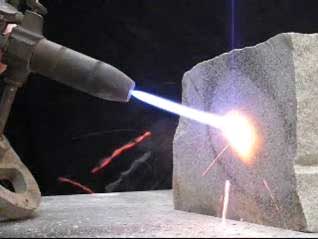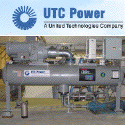Blog Archives
Triple Play: Sou Hills Project
In August, 2007, MeV acquired a lease and development rights on ~1700 acres (~700 hectares) of land in Nevada’s East Dixie Valley. This area is a Known Geothermal Resources Area (KGRA) with a functioning plant, Ormat’s Dixie Valley 60MW facility, in the near vicinity. Given the parcel’s location in the Sou Hills, we now refer to this parcel as the Sou Hills Prospect. One other key aspect to the Sou Hills Prospect is its proximity to electricity transmission. A distribution line is located within 400m of the southern end of the parcel which connects to a 230kv transmission line owned and operated by Sierra Pacific Power Company. MeV has made one preliminary visit to the Sou Hills Prospect which is recorded here.
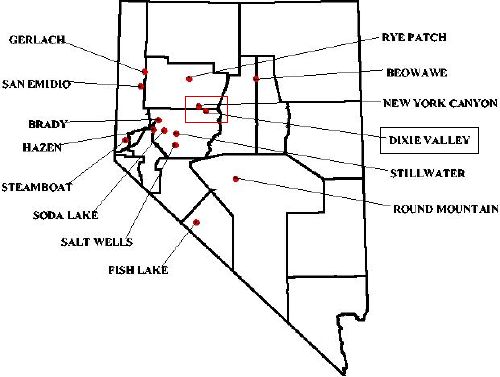
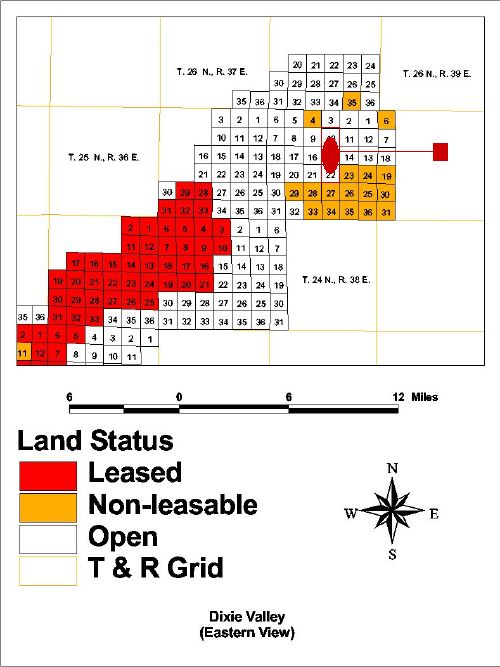
As with any geothermal prospect, exploration is paramount. Before the end of the year, MeV plans to complete aerial, self-potential, soil chemical, and magnetic surveys of the prospect. In addition, MeV plans a 2m shallow temperature survey with at least 100 measurement points (which can and will be adjusted in the field to accommodate the localization of any anomolies.) After collecting and analyzing this data, MeV may drill temperature gradient wells in locations suggested by the analysis of the prior surveys.
In addition to geothermal resource, MeV also observes that this location lies in the desert and is the recipient of copious amounts of sunshine year around. Given that benefit, solar surveys to characterize resource applicability for solar thermal electricity production will also be performed. Finally, there may be wind resource in the area and as such a wind resource analysis will be performed. This will help determine the feasibility of a “double” or “triple” play allowing multi-dimensional harvest of renewable resource below the surface level with geothermal, at surface level with solar thermal, and above surface level with wind all on the same physical property.
(Sou Hills Prospect in Rectangle Area >5 kwh/m2)
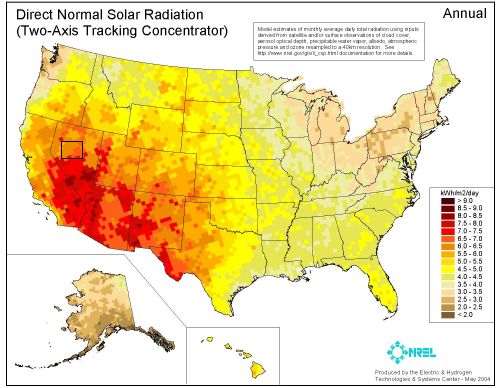
(Sou Hills Prospect in Rectangular Area – Detail in cutout below)
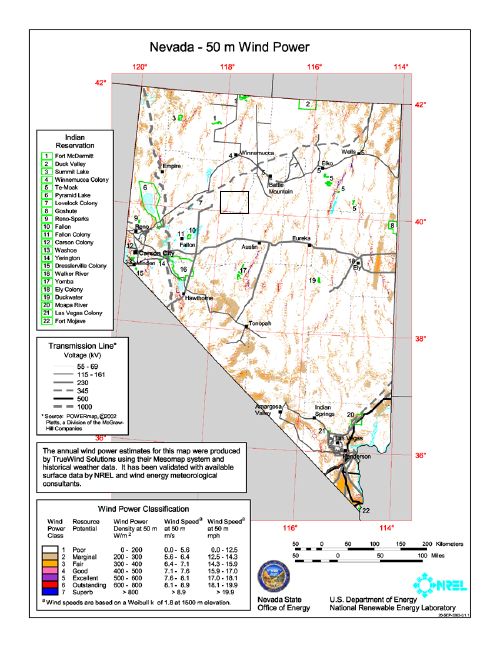
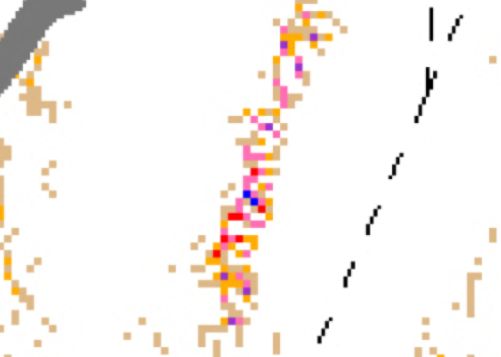
In concert, the wind, solar, and geothermal resources can share the same operations and transmission infrastructure. Solar thermal and geothermal can share the same physical generation resources. As solar resources become unavailable (darkness) wind resources in this area tend to increase and peak during night time hours. Of course, geothermal resources are not subject to sunlight and wind conditions and provide a constant baseload power output from the renewable energy park. Presently, the size and feasibility of this approach are unknown and will not be known until the resource assessment has been completed. However, the conditions are right for this approach to work in this specific property and perhaps others located around the world.
As results of resource surveys become available, we will share those results and the progress of our project in general. Comments are off for this post
Steamboat Springs Geothermal Plant
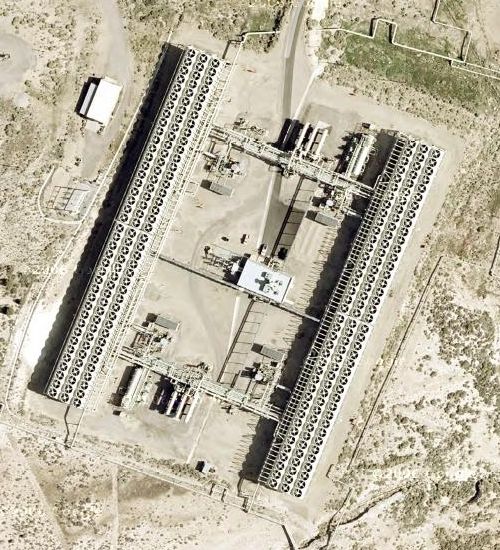
Last week on the way home from the GRC annual meeting, we decided to take a side trip that would take us by the Lower Steamboat Springs Geothermal plant operated by Ormat. The view above is courtesy of Google Maps, the view below was snapped from US 395 about 10 miles south of Reno, Nevada. The entire Steamboat Springs complex (4 plants, Upper and Lower Steamboat Springs) has a nameplate capacity of just over 64 MW.
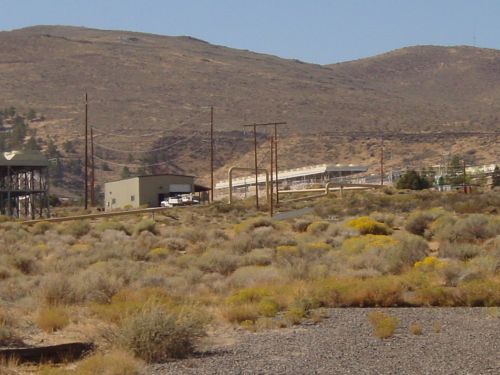
Spallation Drilling
One of the more interesting talks and technologies at the GRC Annual Meeting was given by MIT Researcher Chad Augustine on Spallation Drilling using a hydrogen-oxygen (H2-O2) fuel source. Spallation is essentially catastrophic structural failure of rock when extreme heat is applied in a small area. As the rock heats, small pieces spring free of the face of the rock in micro explosions.
Spallation drilling consists of a torch placed in close physical proximity to the rock face, the application of extreme heat to a small surface area, and removal of the waste material produced by spallation. The trick to this is, how does one get a flame to burn in the presence of water (used to remove the waste material) in an extremely high pressure (250 bar) environment? Chad and team reproduced this environment in a test facility at Potter Drilling in Redwood City and discovered that not only was it possible to keep the flame active in the high pressure aqueous environment, but that temperatures necessary for spallation to occur (500C) were maintained.
This could be an important and cheaper alternative to rotary drilling. And, there are a bunch of holes to be drilled…
Geothermal Resources Council Annual Meeting
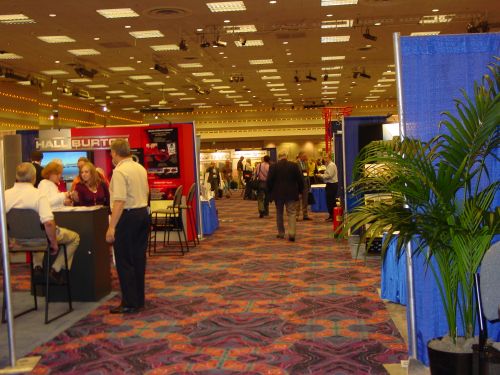
The Geothermal Resources Council (GRC) held its annual meeting this year in Sparks, Nevada at John Ascuaga’s Nugget hotel and convention center October 1-3. The event was heavily attended by developers, service providers, geologists, and financiers and featured several heavyweight speakers including Alexander “Andy” Karsner from the Department of Energy, Michael Olsen from the Department of the Interior, and Nevada Governor Jim Gibbons. The basic structure of the event included special pre-meeting sessions and field trips, a morning of keynote addresses, and then parallel sessions for presenting and sharing geothermal industry breakthroughs over the following days. There was also a tradeshow sponsored by the Geothermal Energy Association that ran during the entire conference. All of this activity was supplemented by dinners, receptions, and many private meetings among the attendees. While the final attendee count was not announced, we estimate there were at least 1,000 people attending the event.
There were 99 breakout sessions available over 21 timeslots (unfortunately, the individual breakout sessions only ran one time, so there were mulitple interesting topics that were competing…) and there was one 2 hour “poster session” where 38 topics were represented (with significant overlap between poster hosts and breakout sessions.) The tradeshow featured at least 50 different exhibitors from service providers (drilling, operations & maintenance, law, finance) to geothermal developers to government and non-profit associations. Over the course of the next few days, you’ll see content from the conference that caught our attention in some detail.
Suffice to say, it was a busy and productive 3 days. The takeaway MeV has from the event is a structured approach to the assessment of the resources on our Sou Hills, Nevada prospect. To whet your appetite for future entries, here are some facts gleaned about geothermal resources in Nevada from the keynote speakers:
- The Nugget (hotel, casino, and convention center) electricity bill is $4M per year
- Nevada’s peak demand is around 8,000MW
- 300MW of geothermal power is being developed in Nevada, to add to the 200+MW already in production
- 556,000 acres of geothermal leases, or 80% of all geothermal leases, are in Nevada
- Geothermal resource estimates for Nevada range from 1,500 to 5,000MW
$1.5B for Solar Thermal
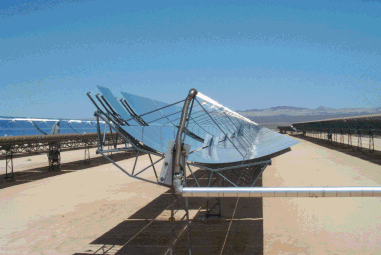
Via Renewable Energy Access:
Comments are off for this postFPL Group Incorporated, a generator of renewable electric power, yesterday announced a $2.4 billion investment program aimed at increasing U.S. solar thermal energy output and reducing carbon dioxide emissions that contribute to global warming.
“These new investments, coupled with our recent announcement to invest an estimated $20 billion in new wind generation, demonstrate FPL Group’s continued commitment to improve the environment.”
–Lew Hay, Chairman and CEO, FPL Group.
The majority of the investment ($1.5 billion) will go in new solar thermal generating facilities in Florida and California over the next seven years, starting with a project at FPL. FPL is planning to build 300 megawatts (MW) of solar generating capacity in Florida using Ausra, Inc.’s solar thermal technology.
